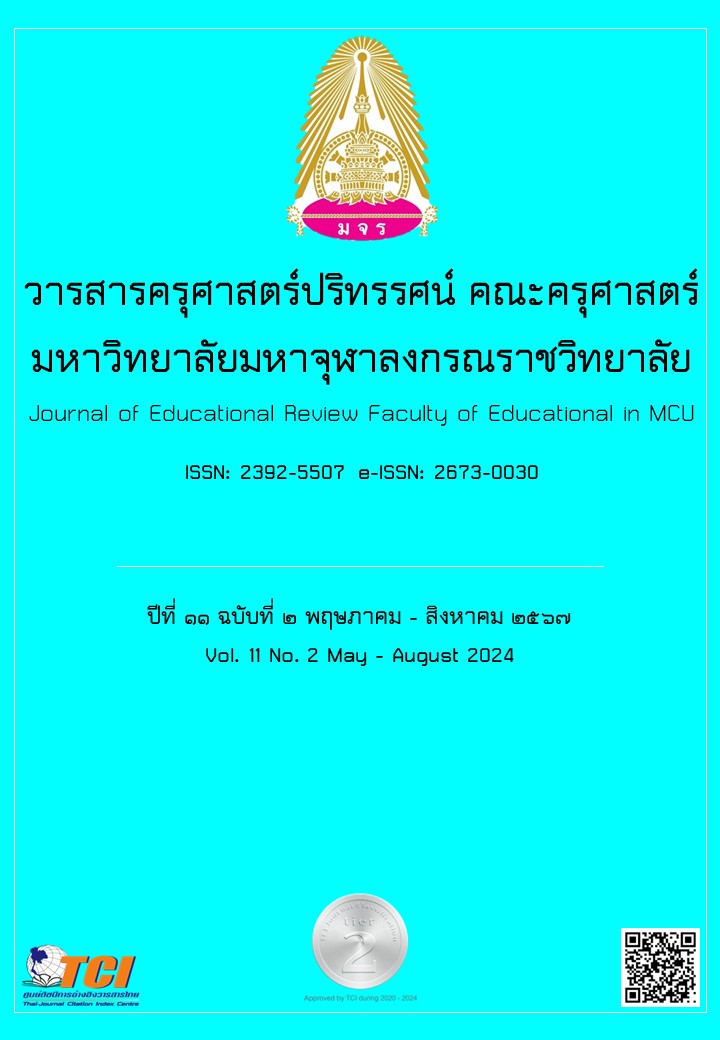รูปแบบภาวะผู้นำทางวิชาการตามหลักสัปปุริสธรรม 7 สำหรับผู้บริหารสถานศึกษา สังกัดสำนักงานเขตพื้นที่การศึกษาประถมศึกษา
Main Article Content
บทคัดย่อ
บทความวิจัยนี้มีวัตถุประสงค์เพื่อเสนอรูปแบบภาวะผู้นำทางวิชาการตามหลักสัปปุริสธรรม 7 สำหรับผู้บริหารสถานศึกษา สังกัดสำนักงานเขตพื้นที่การศึกษาประถมศึกษา เป็นการวิจัยแบบผสานวิธี โดยมีขั้นตอนการวิจัย 3 ขั้นตอน คือ ขั้นตอนที่ 1 ศึกษาความต้องการจำเป็นของภาวะผู้นำทางวิชาการของผู้บริหารสถานศึกษา เป็นการวิจัยเชิงปริมาณใช้แบบสอบถามกลุ่มตัวอย่างที่เป็นครูผู้สอนจำนวน 289 คน มีเครื่องมือในการวิจัยคือแบบสอบถาม ทำการวิเคราะห์ข้อมูลด้วยสถิติพื้นฐาน คือ ค่าความถี่ ค่าร้อยละ ค่าเฉลี่ย ค่าส่วนเบี่ยงเบนมาตรฐาน และค่าความต้องการจำเป็น ขั้นตอนที่ 2 พัฒนารูปแบบ เป็นการวิจัยเชิงคุณภาพด้วยการสัมภาษณ์ผู้ให้ข้อมูลสำคัญ จำนวน 10 รูป/คน และการจัดการสนทนากลุ่มผู้ทรงคุณวุฒิ จำนวน 9 รูป/คน มีเครื่องมือในการวิจัยคือแบบสัมภาษณ์และแนวคำถามการสนทนากลุ่ม ทำการวิเคราะห์ข้อมูลด้วยการวิเคราะห์เนื้อหา และขั้นตอนที่ 3 ประเมินรูปแบบ เป็นการวิจัยเชิงปริมาณใช้แบบประเมินกลุ่มตัวอย่างที่เป็นผู้บริหารสถานศึกษา จำนวน 73 คน มีเครื่องมือการวิจัยคือแบบประเมินรูปแบบ ทำการวิเคราะห์ข้อมูลด้วยสถิติพื้นฐาน คือ ค่าร้อยละ ค่าเฉลี่ย และค่าส่วนเบี่ยงเบนมาตรฐาน ผลการวิจัย พบว่า รูปแบบภาวะผู้นำทางวิชาการตามหลักสัปปุริสธรรม 7 สำหรับผู้บริหารสถานศึกษา สังกัดสำนักงานเขตพื้นที่การศึกษาประถมศึกษา ประกอบด้วย 5 องค์ประกอบ ได้แก่ องค์ประกอบที่ 1 หลักการ สถานศึกษาพัฒนาคุณภาพการบริหารสถานศึกษาอย่างมีประสิทธิผลโดยนำหลักภาวะผู้นำทางวิชาการบูรณาการกับหลักสัปปุริสธรรม 7 องค์ประกอบที่ 2 วัตถุประสงค์ เพื่อให้ผู้บริหารสถานศึกษามีหลักภาวะผู้นำภาวะผู้นำทางวิชาการตามหลักสัปปุริสธรรม 7 ด้วยวิธีการบริหารแบบพุทธบูรณาการ องค์ประกอบที่ 3 การบูรณาการภาวะผู้นำทางวิชาการ (การบริหารจัดการหลักสูตร และการจัดการเรียนรู้) ตามหลักสัปปุริสธรรม 7 องค์ประกอบที่ 4 การประยุกต์ใช้ในการบริหารจัดการสถานศึกษา 4 ด้าน ได้แก่ การบริหารวิชาการ การบริหารงานบุคคล การบริหารงบประมาณ การบริหารทั่วไป และองค์ประกอบที่ 5 การประเมิน และมีผลการประเมินรูปแบบฯ ในภาพรวมมีผลการประเมินอยู่ในระดับมากที่สุด เมื่อพิจารณาเป็นรายด้านมีผลการประเมินอยู่ในระดับมากที่สุดทั้ง 4 ด้าน คือ ความเหมาะสม ความถูกต้อง ความเป็นประโยชน์ ความเป็นไปได้ สรุปองค์ความรู้การวิจัย คือ CASAA ประกอบด้วย C (Curriculum and Learning Management) A (Academic Leadership) S (Sappurisadhamma) A (Administrator) A (Apply)
Article Details

อนุญาตภายใต้เงื่อนไข Creative Commons Attribution-NonCommercial-NoDerivatives 4.0 International License.
ทัศนะและความคิดเห็นที่ปรากฏในบทความในวารสารฉบับนี้ถือเป็นความรับผิดชอบของผู้เขียนบทความนั้นเพียงผู้เดียว และไม่ถือเป็นทัศนะและความรับผิดชอบของกองบรรณาธิการ
กองบรรณาธิการขอสงวนสิทธิ์ในการคัดเลือกบทความลงตีพิมพ์และจะแจ้งให้เจ้าของบทความทราบหลังจากผู้ประเมินบทความตรวจอ่านบทความแล้ว
ต้นฉบับที่ได้รับการตีพิมพ์ในวารสารครุศาสตร์ปริทรรศน์ คณะครุศาสตร์ มหาวิทยาลัยมหาจุฬาลงกรณราชวิทยาลัย ถือเป็นกรรมสิทธิ์ของคณะครุศาสตร์ มหาวิทยาลัยมหาจุฬาลงกรณราชวิทยาลัย ห้ามนำข้อความทั้งหมดหรือบางส่วนไปพิมพ์ซ้ำ เว้นเสียแต่ว่าจะได้รับอนุญาตจากมหาวิทยาลัยฯ เป็นลายลักษณ์อักษร
เอกสารอ้างอิง
จรัส อติวิทยาภรณ์. (2554). หลักการและทฤษฎีทางการบริหารการศึกษา. กรุงเทพมหานคร: มหาวิทยาลัยทักษิณ.
ไชยา ภาวะบุตร. (2555). ภาวะผู้นำทางวิชาการในสถานศึกษา. สกลนคร: มหาวิทยาลัยราชภัฏสกลนคร.
ฐนิตนันท์ ทวีกระแสร์. (2557). การใช้หลักสัปปุริสธรรม 7 ของผู้บริหารสถานศึกษาสหวิทยาเขตเวียงเรือคำ สำนักงานเขตพื้นที่การศึกษามัธยมศึกษาเขต 25. วิทยานิพนธ์พุทธศาสตรมหาบัณฑิต. มหาวิทยาลัยจุฬาลงกรณราชวิทยาลัย.
ธานินท์ ศิลป์จารุ. (2551). การวิจัยและวิเคราะห์ข้อมูลทางสถิติด้วย SPSS. พิมพ์ครั้งที่ 9. กรุงเทพมหานคร: บิสซิเนสอาร์แอนด์ดี.
นาวา สุขรมย์. (2550). การบริหารงานวิชาการ. กรุงเทพมหานคร: แอล.ที.เพรส.
บุญชม ศรีสะอาด. (2535). การวิจัยเบื้องต้น. พิมพ์ครั้งที่ 5. กรุงเทพมหานคร: ชมรมเด็ก.
ปราณี แสนทวีสุข. (2547). การนำเสนอรูปแบบการพัฒนาภาวะผู้นำทางวิชาการสำหรับผู้บริหารสถานศึกษาสังกัดสำนักงานเขตพื้นที่การศึกษาอ่างทอง. วิทยานิพนธ์ครุศาสตรมหาบัณฑิต. สถาบันราชภัฏพระนครศรีอยุธยา.
พระครูโอภาสนนทกิตติ์ (ศักดา โอภาโส). (2557). การวิเคราะห์ทักษะภาวะผู้นำของผู้บริหารตามหลักพุทธธรรมโรงเรียนวิถีพุทธระดับประถมศึกษา จังหวัดนนทบุรี. ดุษฎีนิพนธ์พุทธศาสตรดุษฎีบัณฑิต. มหาวิทยาลัยมหาจุฬาลงกรณราชวิทยาลัย.
พระปลัดณรงค์ธรรม กตธมฺโม (หงษ์สิบสอง). (2561). รูปแบบการพัฒนาภาวะผู้นำของผู้บริหารตามหลักพุทธธรรมโรงเรียนมัธยมศึกษาภาคเหนือตอนล่าง. ดุษฎีนิพนธ์พุทธศาสตรดุษฎีบัณฑิต. มหาวิทยาลัยมหาจุฬาลงกรณราชวิทยาลัย.
พระพรหมคุณาภรณ์ (ป. อ. ปยุตฺโต). (2551). พจนานุกรมพุทธศาสตร์ ฉบับประมวลศัพท์. กรุงเทพมหานคร: ธนธัชการพิมพ์.
พระพรหมคุณาภรณ์ (ป. อ. ปยุตฺโต). (2551). พจนานุกรมพุทธศาสตร์ ฉบับประมวลธรรม. พิมพ์ครั้งที่ 16. กรุงเทพมหานคร: เอส. อาร์. พริ้นติ้ง แมส โปรดักส์.
พระมหาญาณวัฒน์ ฐิตวฑฺฒโน และศุขภิญญา ศรีคำไทย. (2565). การบูรณาการหลักพุทธธรรมกับสมรรถนะของผู้บริหารสถานศึกษา. วารสารบวรสหการศึกษาและมนุษยสังคมศาสตร์. 3(1). 70-78.
มหาจุฬาลงกรณราชวิทยาลัย. (2539). พระไตรปิฎกภาษาไทย ฉบับมหาจุฬาลงกรณราชวิทยาลัย. กรุงเทพมหานคร: มหาจุฬาลงกรณราชวิทยาลัย.
วรภาส ประสมสุข. (2549). หลักการบริหารการศึกษาตามแนวพุทธธรรม. ดุษฎีนิพนธ์การศึกษาดุษฎีบัณฑิต. มหาวิทยาลัยนเรศวร.
วีรยุทธ์ ชาตะกาญจน์. (2551). เทคนิคการบริหารสำหรับนักบริหารการศึกษามืออาชีพ. กรุงเทพมหานคร: วีพริ้น.
สำนักงานเขตพื้นที่การศึกษาประถมศึกษาสิงห์บุรี. (2564). รายงานผลการดำเนินงาน ประจำปี 2564. แหล่งที่มา https://policy.singprimary.go.th/report_budget/peport65 สืบค้นเมื่อ 1 ก.พ. 2566.
สำนักงานเขตพื้นที่การศึกษาประถมศึกษาสิงห์บุรี. (2565). แผนปฏิบัติราชการประจำปีงบประมาณ พ.ศ. 2565. แหล่งที่มา https://policy.singprimary.go.th/plan/plan65 สืบค้นเมื่อ 6 ก.พ. 2566.
สำนักงานเขตพื้นที่การศึกษาประถมศึกษาสิงห์บุรี. (2565). สารสนเทศทางการศึกษา ประจำปีการศึกษา 2565. แหล่งที่มา https://policy.singprimary.go.th/inform_m/EI65 สืบค้นเมื่อ 6 ก.พ. 2566.
สำนักงานคณะกรรมการการศึกษาแห่งชาติ. (2544). พระราชบัญญัติการศึกษาแห่งชาติ พ.ศ.2542 และแก้ไขเพิ่มเติม (ฉบับที่ 2) พ.ศ. 2545. กรุงเทพมหานคร: พริกหวานกราฟฟิค.
สำนักงานคณะกรรมการการศึกษาแห่งชาติ. (2550). สำนักงานเขตพื้นที่การศึกษา. กรุงเทพมหานคร: สำนักงานคณะกรรมการการศึกษาแห่งชาติ.
Keeves, Peter J. (1988). Model and Model Building: Educational Research Methodology and Measurenment : An Intermational Handbook. Oxford: Pergamon Press.
Krejcie, R. V. & Morgan, D. W. (1970). Determining sample size for research activities. Educational and Psychological Measurement. 30(3). 607–610.


